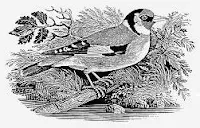 Ever since I got interested in printmaking and going to exhibitions and reading books and online resources I keep seeing the name Thomas Bewick.
Ever since I got interested in printmaking and going to exhibitions and reading books and online resources I keep seeing the name Thomas Bewick.He's known as the 'father of wood engraving' - so I've started to find out more about him - and this post marks the beginning of that exercise.
I've also created a website to record all my bookmarks - which I can then share with others who are also interested - Thomas Bewick - Resources for Art Lovers
Barn Owl Tyto alba by Thomas Bewick
History of British Birds (Land Birds)
This particular post is prompted by an exhibition in Birmingham and a video I watched yesterday. Those enthusiastic about one of the very great wood engravers and/or natural history and/or wildlife art and/or miniature art won't want to miss Thomas Bewick: Tale-Pieces at the Ikon gallery in Birmingham until 25 May.
This pdf file explains what the exhibition is about and there's also a video about Thomas Bewick by Ian Bain - a printing historian and authority of Thomas Bewick. Anybody who is interested in printmaking will be absolutely fascinated by this interview.
This is the Guardian's review of the exhibition - All the world in two by three inches is an article.
We know Bewick for his beautiful woodcuts of birds, but his detail-laden vignettes of country people are as rich as Goya or Blake..... Bewick's engravings are amazingly small - two or three inches - and minutely amazing. Peer into these tiny vignettes and both your pupils and your mind dilate. How can so much of life be condensed?Why is Thomas Bewick special?
(Left) Dalmation (1790) by Thomas Bewick 4.9 x 8.3 cm
(Right) Goldfinch (1797) by Thomas Bewick 5 x 8 cm
Thomas Bewick has multiple claims to fame.(Right) Goldfinch (1797) by Thomas Bewick 5 x 8 cm
- Thomas Bewick revolutionised wood engraving in the eighteenth century by using tools previously used for engraving on metals on hard box wood
- Bewick pioneered the use of a wood engraving (cut on the end grain of a hard wood such as boxwood) so that it could be printed simultaneously with the letterpress. This meant that an illustration could appear on the same page as its related text.
- He was both an artist and an engraver. His work demonstrates both an excellent ability to observe and draw from life and a dexterity in skill in engraving never seen before on wood and rarely seen since
- he loved nature, animals and birds and developed two comprehensive works A General History of Quadrupeds: The Figures Engraved on Wood (1790) and A History of British Birds - published in two columes for Land Birds (1797) and Water Birds (1804)
- Most of his work is small in scale and some of it confounds the eye and would grace any exhibition of miniature art.


Wonderful post, Katherine. The video is a gem. Thank you.
ReplyDeleteI'm studying a book on wood engraving at the moment and trying to resist accumulating more cutting tools. Also thinking boxwood blocks will be so expensive and are my eyes up to it anyway? So many of these wonderful marks can be made relevant to other forms of relief printing - lino for example but of course not on the miniature scale of this master.
Katherine, thanks so much for tying together such great Bewick information! You never cease to amaze me. Can't wait to see the video.
ReplyDelete